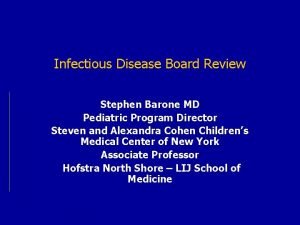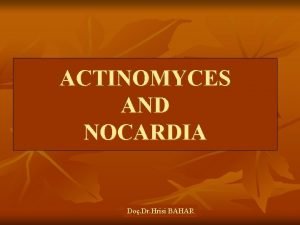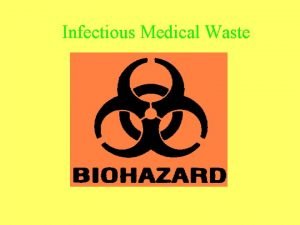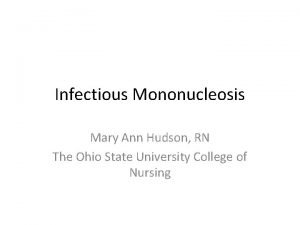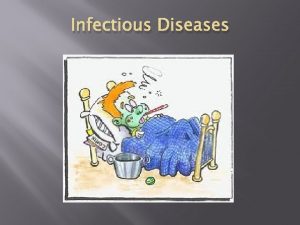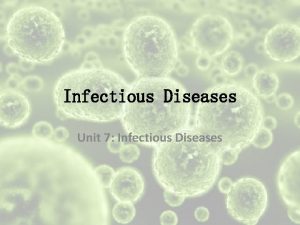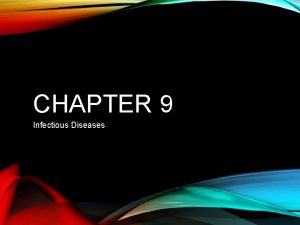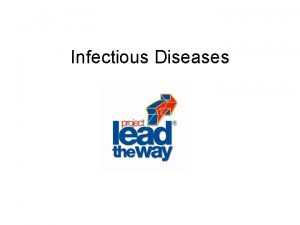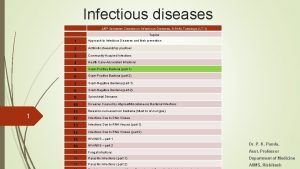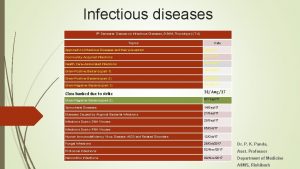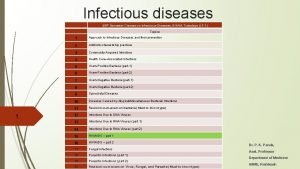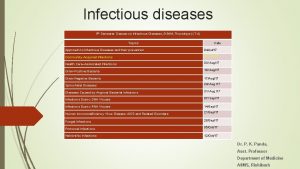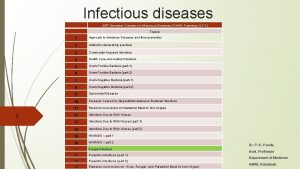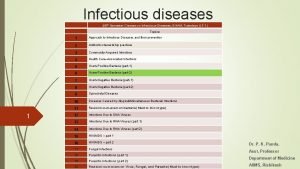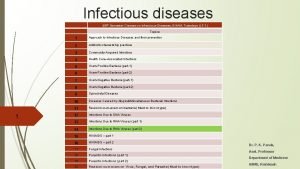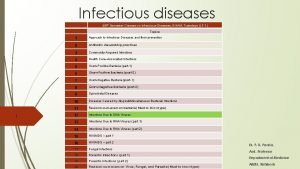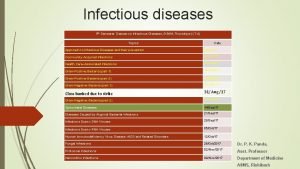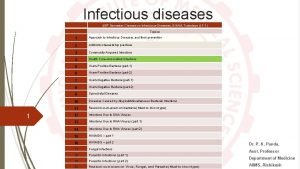Infectious diseases 5 th Semester Classes on Infectious





















- Slides: 21

Infectious diseases 5 th Semester Classes on Infectious Diseases, 8 -9 AM, Thursdays (LT-4) Topics Date Approach to Infectious Diseases and their prevention 04/Jul/17 Community-Acquired Infections 27/ Jul /17 Health Care–Associated Infections 03/ Aug/17 Gram-Positive Bacteria 10/ Aug/17 Gram-Negative Bacteria 17/Aug/17 Spirochetal Diseases 24/ Aug /17 Diseases Caused by Atypical Bacterial Infections 31/ Aug /17 Infections Due to DNA Viruses 07/ Sep/17 Infections Due to RNA Viruses 14/Sep/17 Human Immunodeficiency Virus Disease: AIDS and Related Disorders 21/Sep/17 Fungal Infections 28/Sep/17 Protozoal Infections 05/Oct/17 Helminthic Infections 12/Oct/17 Dr. P. K. Panda, Asst. Professor Department of Medicine AIIMS, Rishikesh

Surveillance, prevention, and treatment “Zero tolerance”—all health care–associated infections should be avoidable with strict application of evidence-based prevention guidelines Nosocomial infections follow basic epidemiologic patterns The mode of transmission usually is either cross-infection or autoinoculation Surveillance requires review of microbiology laboratory results, “shoe-leather” epidemiology on nursing wards, and application of standardized definitions of infection “House-wide” surveillance, Not used now-a-days

UTI (30– 40%) SURGICAL WOUND INFECTIONS (15– 20%) PNEUMONIA (10– 15%) INFECTIONS RELATED TO VASCULAR ACCESS (10– 15%) GROUP A STREPTOCOCCAL INFECTIONS FUNGAL INFECTIONS LEGIONELLOSIS ANTIBIOTIC-RESISTANT BACTERIA CA-MRSA VIRAL RESPIRATORY INFECTIONS Plasmid mediated resistance to fluoroquinolones NOSOCOMIAL DIARRHEA Metallo-β-lactamase mediated resistance to carbapenems CHICKENPOX KPCs (carbapenemase-producing strains of K. pneumonia) TUBERCULOSIS Panresistant strains of Acinetobacter

UTI The most common pathogens are Escherichia coli, nosocomial gram-negative bacilli, enterococci, and Candida Patients with chronic indwelling bladder catheters, especially those in long-term-care facilities, “catheter flora” may differ from actual urinary tract pathogens. Therefore, obtain a freshly voided urine specimen Repeat the culture to verify the persistence of infection after treatment initiation Other source of infection in a febrile hospitalized patient should be evaluated e. g. recovery of Staphylococcus aureus from urine cultures may result from hematogenous seeding Candida is now the most common pathogen in intensive care units (ICUs)associated UTI, treatment is recommended only when there is; upper-pole or bladder-wall invasion, obstruction, neutropenia, or immunosuppression


SURGICAL WOUND INFECTIONS The most common pathogens are S. aureus, coagulase-negative staphylococci, and enteric and anaerobic bacteria. In rapidly progressing postoperative infections manifesting within 24– 48 h of a surgical procedure, group A streptococcal or clostridial infection more common


PNEUMONIA Early-onset nosocomial pneumonia, which manifests within the first 4 days of hospitalization, is most often caused by community-acquired pathogens such as Streptococcus pneumonia and Haemophilus species Late-onset pneumonias most commonly are due to S. aureus, P. aeruginosa, Enterobacter species, Klebsiella pneumoniae, or Acinetobacter


INFECTIONS RELATED TO VASCULAR ACCESS The most common pathogens include coagulase-negative staphylococci, S. aureus, enterococci, nosocomial gram-negative bacilli, and Candida


Hospitals’ infection-control programs


Standard precautions are designed for the care of all patients in hospitals and aim to reduce the risk of transmission of microorganisms from both recognized and unrecognized sources These precautions include gloving as well as hand cleansing for potential contact with (1) blood; (2) all other body fluids, secretions, and excretions, whether or not they contain visible blood; (3) nonintact skin; and (4) mucous Membranes. Depending on exposure risks, standard precautions also include use of N 95 respirators, surgical face masks, or glove and gown for airborne, droplet, or contact exposure respectively Other measures of standard precautions; Prevention of needle stick injury Environmental cleansing and spill management Waste management





EMPLOYEE HEALTH SERVICE Contagious-disease history can be taken; Evidence of immunity to a variety of diseases, such as hepatitis B, chickenpox, measles, mumps, and rubella, can be sought; Immunizations for hepatitis B, measles, mumps, rubella, varicella, Influenza, and pertussis can be given as needed; Baseline tuberculosis testing can be performed; Education about personal responsibility for infection control can be initiated

Protocols for dealing with workers exposed to contagious diseases (e. g. , influenza) and those percutaneously or mucosally exposed to the blood of patients infected with HIV or hepatitis B or C virus. For example, postexposure HIV prophylaxis (PEP) Protocols for dealing with caregivers who have common contagious diseases (such as chickenpox, group A streptococcal infection, influenza or another respiratory infection, or infectious diarrhea) and for those who have less common but high-visibility public health problems (such as chronic hepatitis B or C or HIV infection)

Thank you Next Class Gram-Positive Bacteria 10/ Aug/17
 Certain infectious and parasitic diseases
Certain infectious and parasitic diseases Emerging infectious diseases
Emerging infectious diseases O que é classe e subclasse
O que é classe e subclasse Pre ap classes vs regular classes
Pre ap classes vs regular classes Hennepin county infectious disease manual
Hennepin county infectious disease manual Infectious canine hepatitis in dogs
Infectious canine hepatitis in dogs Infectious nucleic acid
Infectious nucleic acid Stages of infection
Stages of infection Poisonous and infectious material symbol
Poisonous and infectious material symbol Infectious disease board review
Infectious disease board review Infectious disease
Infectious disease Lead poisoning
Lead poisoning Chapter 26 infectious disease prevention and control
Chapter 26 infectious disease prevention and control Quizlet
Quizlet Smallest infectious agent
Smallest infectious agent Infectious waste management
Infectious waste management Infectious mononucleosis
Infectious mononucleosis Stages of infectious disease
Stages of infectious disease Infectious stunting syndrome
Infectious stunting syndrome Infectious canine hepatitis in dogs
Infectious canine hepatitis in dogs Infectious disease quality controls
Infectious disease quality controls Waterwashed diseases
Waterwashed diseases









